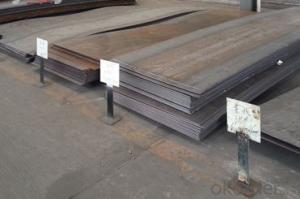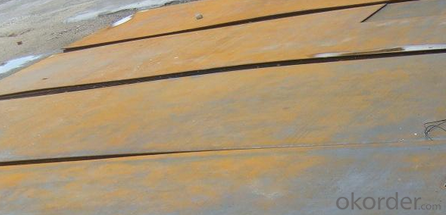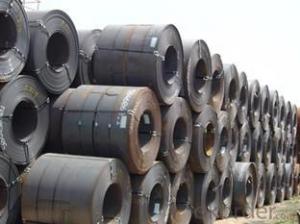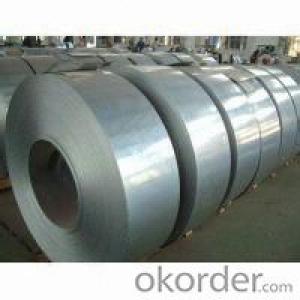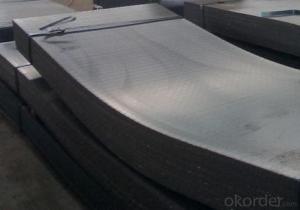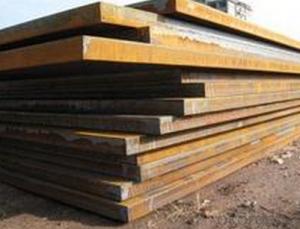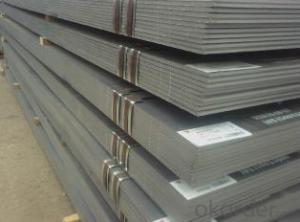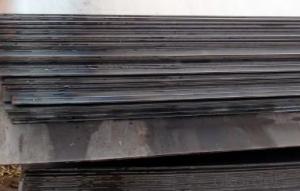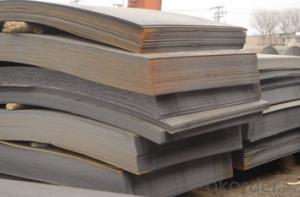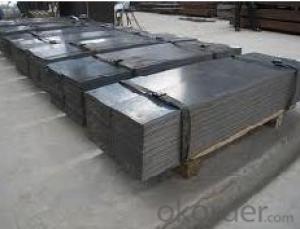Hot Rolled Carbon Steel Plate,Carbon Steel Sheet LRA32, CNBM
- Loading Port:
- Qingdao
- Payment Terms:
- TT OR LC
- Min Order Qty:
- 10 pc
- Supply Capability:
- 30 pc/month
OKorder Service Pledge
Quality Product, Order Online Tracking, Timely Delivery
OKorder Financial Service
Credit Rating, Credit Services, Credit Purchasing
You Might Also Like
Quick Details
| Standard: | AISI, ASTM, DIN, GB, JIS | Grade: | A572,A573,A633,A678,A709,A710,G3101,G3136,etc | Thickness: | 1mm-200mm |
| Brand Name: | SHOU GANG GROUP, AN STEEL | Model Number: | Q235 | ||
| Type: | Steel Plate | Technique: | Hot Rolled | Surface Treatment: | Coated |
| Application: | widely | Special Use: | High-strength Steel Plate | Width: | 1000mm-3000mm |
| Length: | 1000mm-12000mm | Price Term: | FOB CIF CFR |
Packaging & Delivery
| Packaging Details: | standard seaworthy export packing or as the request of customers |
| Delivery Detail: | 10 days after deposit or according to customers' quantity |
Specifications
hot rolled carbon steel sheet
1.Thickness:1mm-200mm
2.Length:1000mm-12000mm
3.Width:1000mm-2000mm
hot rolled carbon steel sheet
| Product | HR steel plate prices carbon steel plate prices per kg |
| MOQ | 25 ton |
| Thickness | 1mm-200mm |
| Width | 1000mm-3000mm |
| Length | 1000mm-12000mm |
| Application | widely |
| Standard | AISI,ASTM,BS,DIN,JIS,GB,etc |
| Grade | A572,A573,A633,A678,A709,A710,G3101,G3136,etc |
| Tpye | Steel plate |
| Surfacing | Coated |
| Productive Technology | Hot Rolled & Cold Rolled |
| Port | |
| Payment Terms | L/C,T/T,Western Union,MoneyGram |
| Product Ability | 5000 tons per month |
| Delivery | 10 days after deposit or according to customers' quantity |
| Packing | standard seaworthy export packing or as the request of customers |
- Q: How do steel sheets handle static electricity?
- Steel sheets possess excellent electrical conductivity, including the conduction of static electricity. This is due to their high electrical conductivity, allowing them to swiftly eliminate any static charge that accumulates on their surfaces. The effectiveness in handling static electricity is mainly attributed to the presence of unbound electrons within the atomic structure of the steel. When a static charge is applied to a steel sheet, these unbound electrons promptly relocate themselves, nullifying the charge and preventing the accumulation or release of static electricity. Furthermore, steel sheets are frequently coated with a thin protective layer, such as zinc or paint, which further enhances their capacity to dissipate static charges. In general, steel sheets are renowned for their dependable performance in managing static electricity and are commonly utilized in various industrial applications where electrostatic discharge may pose risks to safety or cause damage.
- Q: What are the standard dimensions for steel sheets?
- The standard dimensions for steel sheets vary depending on the specific type and grade of steel, but commonly used dimensions include 4 feet by 8 feet, 4 feet by 10 feet, and 5 feet by 10 feet.
- Q: Are steel sheets suitable for automotive body panels?
- Yes, steel sheets are suitable for automotive body panels. They provide excellent strength, durability, and crash-resistance, making them a popular choice in the automotive industry. Additionally, steel sheets are cost-effective and easily customizable, making them an ideal material for automotive body panels.
- Q: What is the average cost of stainless steel sheets?
- Various factors, such as the grade, thickness, size, and supplier, contribute to the fluctuating average cost of stainless steel sheets. Prices for these sheets typically span from $30 to $300 per sheet. Lower-grade options tend to be budget-friendly, whereas higher-grade varieties can be pricier. Moreover, thicker sheets command a higher price due to the increased material used. Considering these elements and exploring multiple options is crucial to finding the most suitable price and quality for your individual requirements.
- Q: Are steel sheets suitable for building envelopes or curtain walls?
- Yes, steel sheets are suitable for building envelopes or curtain walls. Steel is a versatile and durable material that offers structural strength and can withstand various weather conditions. Additionally, steel sheets can be easily fabricated and customized to meet specific design requirements, making them a popular choice for constructing building envelopes and curtain walls.
- Q: Are steel sheets resistant to vibrations?
- Yes, steel sheets are generally resistant to vibrations due to their high strength and stiffness.
- Q: Can steel sheets be used in the aerospace industry?
- Yes, steel sheets can be used in the aerospace industry. While aluminum is the most commonly used material in aerospace due to its lightweight properties, steel sheets are still utilized in certain applications where high strength and durability are required, such as in the construction of landing gear components or structural parts of aircraft engines.
- Q: What are hot and cold plates?
- Cold rolled coil is made of hot rolled coil as raw material and rolled under the recrystallization temperature at room temperature, including plate and coil. Many steel mills in China, such as Baosteel, WISCO, Anshan Iron and steel company, can be produced. Among them, the delivery is called steel plate, also known as "box plate" or "flat"; the length is very long, the volume of delivery, known as "steel band", also known as "coil.".
- Q: How do you calculate the square footage of a ton of steel?
- The weight of the steel plate is 7.85 tons / cubic meter.The area of 1 ton steel plate (thickness 0.5mm) is: steel plate weight / (steel plate weight * steel plate thickness) =1000/ (7.85*0.5) =254.78 square metersThe total number of steel sheets of 1 tons 1500mm*1800mm*0.5mm specification is 254.78/ (1.5*1.8) =94.36 sheets1500mm*1800mm*0.5mm specification steel plate, each weight is 1.5*1.8*7.85*0.5=10.6 kg
- Q: What is the impact resistance of steel sheets?
- The impact resistance of steel sheets is generally high due to the material's inherent strength and durability. Steel sheets can withstand heavy impacts without deforming or breaking, making them suitable for various applications where protection against impact or force is crucial.
Send your message to us
Hot Rolled Carbon Steel Plate,Carbon Steel Sheet LRA32, CNBM
- Loading Port:
- Qingdao
- Payment Terms:
- TT OR LC
- Min Order Qty:
- 10 pc
- Supply Capability:
- 30 pc/month
OKorder Service Pledge
Quality Product, Order Online Tracking, Timely Delivery
OKorder Financial Service
Credit Rating, Credit Services, Credit Purchasing
Similar products
Hot products
Hot Searches
Related keywords

